[English] 日本語
 Yorodumi
Yorodumi- PDB-6q0b: Poliovirus (Type 1 Mahoney), receptor-catalysed 135S particle inc... -
+ Open data
Open data
- Basic information
Basic information
| Entry | Database: PDB / ID: 6q0b | ||||||
|---|---|---|---|---|---|---|---|
| Title | Poliovirus (Type 1 Mahoney), receptor-catalysed 135S particle incubated with anti-VP1 mAb at RT for 1 hr | ||||||
 Components Components |
| ||||||
 Keywords Keywords | VIRUS/IMMUNE SYSTEM / poliovirus / cell-entry intermediate / expanded virus / a-particle / VIRUS-IMMUNE SYSTEM complex | ||||||
| Function / homology |  Function and homology information Function and homology informationsymbiont-mediated suppression of host translation initiation / symbiont-mediated suppression of host cytoplasmic pattern recognition receptor signaling pathway via inhibition of RIG-I activity / symbiont-mediated suppression of host cytoplasmic pattern recognition receptor signaling pathway via inhibition of MDA-5 activity / symbiont-mediated suppression of host cytoplasmic pattern recognition receptor signaling pathway via inhibition of MAVS activity / ribonucleoside triphosphate phosphatase activity / picornain 2A / symbiont-mediated suppression of host mRNA export from nucleus / symbiont genome entry into host cell via pore formation in plasma membrane / picornain 3C / T=pseudo3 icosahedral viral capsid ...symbiont-mediated suppression of host translation initiation / symbiont-mediated suppression of host cytoplasmic pattern recognition receptor signaling pathway via inhibition of RIG-I activity / symbiont-mediated suppression of host cytoplasmic pattern recognition receptor signaling pathway via inhibition of MDA-5 activity / symbiont-mediated suppression of host cytoplasmic pattern recognition receptor signaling pathway via inhibition of MAVS activity / ribonucleoside triphosphate phosphatase activity / picornain 2A / symbiont-mediated suppression of host mRNA export from nucleus / symbiont genome entry into host cell via pore formation in plasma membrane / picornain 3C / T=pseudo3 icosahedral viral capsid / host cell cytoplasmic vesicle membrane / nucleoside-triphosphate phosphatase / channel activity / monoatomic ion transmembrane transport / RNA helicase activity / endocytosis involved in viral entry into host cell / symbiont-mediated activation of host autophagy / RNA-directed RNA polymerase / cysteine-type endopeptidase activity / viral RNA genome replication / RNA-directed RNA polymerase activity / DNA-templated transcription / virion attachment to host cell / host cell nucleus / structural molecule activity / proteolysis / RNA binding / zinc ion binding / ATP binding / membrane Similarity search - Function | ||||||
| Biological species |  Poliovirus type 1 Poliovirus type 1 | ||||||
| Method | ELECTRON MICROSCOPY / single particle reconstruction / cryo EM / Resolution: 3.4 Å | ||||||
 Authors Authors | Hogle, J.M. / Filman, D.J. / Shah, P.N.M. | ||||||
| Funding support |  United States, 1items United States, 1items
| ||||||
 Citation Citation |  Journal: PLoS Pathog / Year: 2020 Journal: PLoS Pathog / Year: 2020Title: Cryo-EM structures reveal two distinct conformational states in a picornavirus cell entry intermediate. Authors: Pranav N M Shah / David J Filman / Krishanthi S Karunatilaka / Emma L Hesketh / Elisabetta Groppelli / Mike Strauss / James M Hogle /    Abstract: The virions of enteroviruses such as poliovirus undergo a global conformational change after binding to the cellular receptor, characterized by a 4% expansion, and by the opening of holes at the two ...The virions of enteroviruses such as poliovirus undergo a global conformational change after binding to the cellular receptor, characterized by a 4% expansion, and by the opening of holes at the two and quasi-three-fold symmetry axes of the capsid. The resultant particle is called a 135S particle or A-particle and is thought to be on the pathway to a productive infection. Previously published studies have concluded that the membrane-interactive peptides, namely VP4 and the N-terminus of VP1, are irreversibly externalized in the 135S particle. However, using established protocols to produce the 135S particle, and single particle cryo-electron microscopy methods, we have identified at least two unique states that we call the early and late 135S particle. Surprisingly, only in the "late" 135S particles have detectable levels of the VP1 N-terminus been trapped outside the capsid. Moreover, we observe a distinct density inside the capsid that can be accounted for by VP4 that remains associated with the genome. Taken together our results conclusively demonstrate that the 135S particle is not a unique conformation, but rather a family of conformations that could exist simultaneously. | ||||||
| History |
|
- Structure visualization
Structure visualization
| Movie |
 Movie viewer Movie viewer |
|---|---|
| Structure viewer | Molecule:  Molmil Molmil Jmol/JSmol Jmol/JSmol |
- Downloads & links
Downloads & links
- Download
Download
| PDBx/mmCIF format |  6q0b.cif.gz 6q0b.cif.gz | 210.6 KB | Display |  PDBx/mmCIF format PDBx/mmCIF format |
|---|---|---|---|---|
| PDB format |  pdb6q0b.ent.gz pdb6q0b.ent.gz | 166.3 KB | Display |  PDB format PDB format |
| PDBx/mmJSON format |  6q0b.json.gz 6q0b.json.gz | Tree view |  PDBx/mmJSON format PDBx/mmJSON format | |
| Others |  Other downloads Other downloads |
-Validation report
| Summary document |  6q0b_validation.pdf.gz 6q0b_validation.pdf.gz | 1.1 MB | Display |  wwPDB validaton report wwPDB validaton report |
|---|---|---|---|---|
| Full document |  6q0b_full_validation.pdf.gz 6q0b_full_validation.pdf.gz | 1.1 MB | Display | |
| Data in XML |  6q0b_validation.xml.gz 6q0b_validation.xml.gz | 52.7 KB | Display | |
| Data in CIF |  6q0b_validation.cif.gz 6q0b_validation.cif.gz | 79.6 KB | Display | |
| Arichive directory |  https://data.pdbj.org/pub/pdb/validation_reports/q0/6q0b https://data.pdbj.org/pub/pdb/validation_reports/q0/6q0b ftp://data.pdbj.org/pub/pdb/validation_reports/q0/6q0b ftp://data.pdbj.org/pub/pdb/validation_reports/q0/6q0b | HTTPS FTP |
-Related structure data
| Related structure data |  20546MC  6p9oC  6p9wC  6pszC M: map data used to model this data C: citing same article ( |
|---|---|
| Similar structure data |
- Links
Links
- Assembly
Assembly
| Deposited unit | 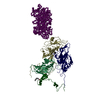
|
|---|---|
| 1 | x 60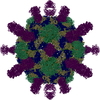
|
| 2 |
|
| 3 | x 5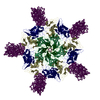
|
| 4 | x 6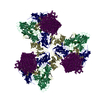
|
| 5 | 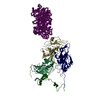
|
| Symmetry | Point symmetry: (Schoenflies symbol: I (icosahedral)) |
- Components
Components
| #1: Protein | Mass: 33488.613 Da / Num. of mol.: 1 / Fragment: UNP residues 580-881 / Source method: isolated from a natural source / Source: (natural)   Poliovirus type 1 (strain Mahoney) / Strain: Mahoney / References: UniProt: P03300 Poliovirus type 1 (strain Mahoney) / Strain: Mahoney / References: UniProt: P03300 |
|---|---|
| #2: Protein | Mass: 30075.783 Da / Num. of mol.: 1 / Fragment: UNP residues 70-341 / Source method: isolated from a natural source / Source: (natural)   Poliovirus type 1 (strain Mahoney) / Strain: Mahoney / References: UniProt: P03300 Poliovirus type 1 (strain Mahoney) / Strain: Mahoney / References: UniProt: P03300 |
| #3: Protein | Mass: 26547.482 Da / Num. of mol.: 1 / Fragment: UNP residues 342-579 / Source method: isolated from a natural source / Source: (natural)   Poliovirus type 1 (strain Mahoney) / Strain: Mahoney / References: UniProt: P03300 Poliovirus type 1 (strain Mahoney) / Strain: Mahoney / References: UniProt: P03300 |
| #4: Protein | Mass: 7690.482 Da / Num. of mol.: 1 / Fragment: UNP residues 2-70 / Source method: isolated from a natural source / Source: (natural)   Poliovirus type 1 (strain Mahoney) / Strain: Mahoney / References: UniProt: P03300 Poliovirus type 1 (strain Mahoney) / Strain: Mahoney / References: UniProt: P03300 |
| #5: Protein | Mass: 44452.984 Da / Num. of mol.: 1 / Source method: isolated from a natural source / Source: (natural)  |
| Has ligand of interest | N |
-Experimental details
-Experiment
| Experiment | Method: ELECTRON MICROSCOPY |
|---|---|
| EM experiment | Aggregation state: PARTICLE / 3D reconstruction method: single particle reconstruction |
- Sample preparation
Sample preparation
| Component | Name: Poliovirus type 1 (strain Mahoney) / Type: VIRUS / Entity ID: #1-#3 / Source: NATURAL |
|---|---|
| Molecular weight | Value: 10.0 MDa / Experimental value: NO |
| Source (natural) | Organism:   Poliovirus type 1 (strain Mahoney) Poliovirus type 1 (strain Mahoney) |
| Details of virus | Empty: NO / Enveloped: NO / Isolate: STRAIN / Type: VIRION |
| Natural host | Organism: Homo sapiens |
| Virus shell | Name: Capsid / Diameter: 300 nm / Triangulation number (T number): 1 |
| Buffer solution | pH: 7.5 / Details: 20 mM Tris-HCl, pH 7.5, 2 mM CaCl2 |
| Specimen | Conc.: 0.4 mg/ml / Embedding applied: NO / Shadowing applied: NO / Staining applied: NO / Vitrification applied: YES / Details: This sample was monodisperse. |
| Specimen support | Details: unspecified |
| Vitrification | Instrument: FEI VITROBOT MARK IV / Cryogen name: ETHANE / Humidity: 100 % / Chamber temperature: 277 K |
- Electron microscopy imaging
Electron microscopy imaging
| Experimental equipment |  Model: Talos Arctica / Image courtesy: FEI Company |
|---|---|
| Microscopy | Model: FEI TECNAI ARCTICA |
| Electron gun | Electron source:  FIELD EMISSION GUN / Accelerating voltage: 200 kV / Illumination mode: SPOT SCAN FIELD EMISSION GUN / Accelerating voltage: 200 kV / Illumination mode: SPOT SCAN |
| Electron lens | Mode: BRIGHT FIELD / Alignment procedure: COMA FREE |
| Specimen holder | Cryogen: NITROGEN / Specimen holder model: FEI TITAN KRIOS AUTOGRID HOLDER |
| Image recording | Electron dose: 1.06 e/Å2 / Detector mode: COUNTING / Film or detector model: GATAN K3 (6k x 4k) / Num. of grids imaged: 1 |
- Processing
Processing
| EM software |
| ||||||||||||||||||||||||||||||||||||
|---|---|---|---|---|---|---|---|---|---|---|---|---|---|---|---|---|---|---|---|---|---|---|---|---|---|---|---|---|---|---|---|---|---|---|---|---|---|
| CTF correction | Type: PHASE FLIPPING AND AMPLITUDE CORRECTION | ||||||||||||||||||||||||||||||||||||
| Symmetry | Point symmetry: I (icosahedral) | ||||||||||||||||||||||||||||||||||||
| 3D reconstruction | Resolution: 3.4 Å / Resolution method: FSC 0.143 CUT-OFF / Num. of particles: 17697 / Symmetry type: POINT | ||||||||||||||||||||||||||||||||||||
| Atomic model building | Protocol: FLEXIBLE FIT / Space: REAL |
 Movie
Movie Controller
Controller







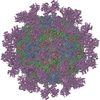



 PDBj
PDBj

